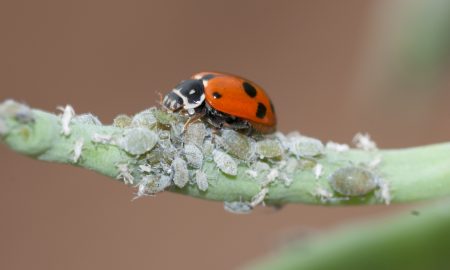European earwigs can be a problem in stubble-retained paddocks, which provide refuges to allow population build up and survival.
Where have they been reported?
In mid April following an unusually early break, European earwigs have been observed causing damage to young canola seedlings around Harden in the South West Slopes of NSW. Large numbers of this pest were widespread within a canola crop, chewing the edges of canola cotyledons and leaves. A ‘nest’, or focussed point of breeding for this social pest was found beneath a tree in a neighbouring paddock that was thought to be the source of infestation (although there may have been many other such nests within and around the crop).
Pest habits and behaviour
European earwigs are an introduced species that appear to be spreading in southern agricultural areas, and problems are often associated with high levels of retained stubble from year to year. They have been known to cause damage to several crop types including canola, cereals and some legumes.
The European earwig (Forficula auricularia) is nocturnal and both nymphs and adults shelter in dark places, such as under trash or within cracks in the soil, during the day. Monitoring should therefore be conducted at night when the earwigs are active. European earwigs feed on leaves and stems, often in clusters and can chew plants down to ground level. They can also feed underground on germinating seed. Typical earwig damage appears as irregular shaped holes in leaves or shredded leaves and leaf tips; this slows plant development. European earwig damage can sometimes resemble snail damage. European earwigs are often patchily distributed and damage can be scattered within a paddock.
European earwigs tend to exist communally and will generally appear more abundant than native earwigs. Because of their communal behaviour, the earwigs tend to feed on a front at night, starting at the edge and moving deeper into the crop with time. Female earwigs display maternal care, remaining in the burrow protecting the eggs and nymphs.
There are several earwig species, but only the introduced European earwig consistently causes crop damage in broadacre crops. Native earwig species include the common brown earwig (Labidura truncata) and the black field earwig (Nala lividipes). The common brown earwig is a beneficial insect that feeds on soft-bodied insects such as caterpillars, lucerne flea and mites, but not plants. The black field earwig is a minor pest species of broadacre agriculture, only occasionally attacking crops.
Our advice
In order to make the most appropriate management decision and accurately assess the risk of attack to emerging crop seedlings, it is important to distinguish the European and native earwig species, all of which may inhabit crops. If earwigs damage is suspected, it is best to search for earwigs at night and look for direct evidence they are feeding on plants. During the day, it is best to search under rocks, stubble residue, wood, or to dig up the soil with a spade.
Control options
There are no foliar insecticides currently registered for European earwigs in broadacre crops, however, insecticide seed dressings may give some control of earwig numbers. Ensure seed dressings are registered for use on the particular crop in your state. Cracked wheat or cracked sorghum bait prepared with chlorpyrifos and sunflower oil, then broadcast onto the infested area is reported to provide some success against European earwigs.
Description
The European earwig has a dark and relatively uniform body colour with distinctly yellowish shoulders, legs and pincers. They range in size from 12-24 mm long. They have smooth flat elongated bodies and may be winged or wingless. Winged earwigs have two sets of wings, a short hardened forewing and a soft membranous hindwing. They have chewing mouthparts, bead-like antennae and 2 pincers at the rear of the body. Males have longer curved pincers, whereas females have straight pincers. Adults and nymphs are of similar appearance, but nymphs are smaller and paler.
The common brown earwig can be distinguished from the European earwig by the presence of an orange coloured triangle behind the head on the elytra or ‘wing-case’. The black field earwig is smaller at about 15 mm long, and is shiny black in colour.
Acknowledgements
Sources of field reports of earwigs
Tim Condon – Agronomist, Delta Ag (NSW South West Slopes)
Cover image: Photo by Lisa Kirkland, Cesar Australia





